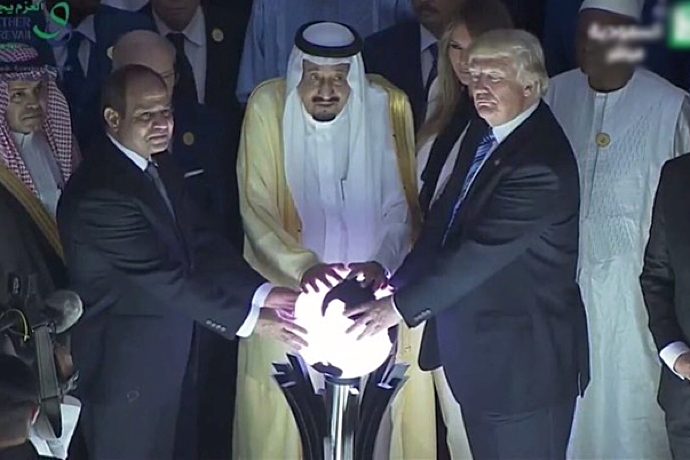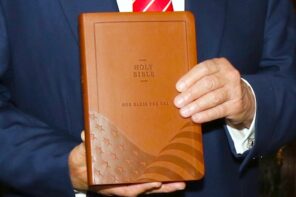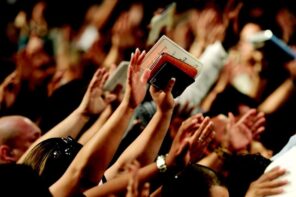It was billed as unprecedented, a religion-themed tour to “broadcast a message of unity” to followers of the Abrahamic faiths by visiting, in the words of national security adviser General H.R. McMaster, “the homelands and holy sites of the Jewish, Christian, and Muslims faiths all on one trip.”
From Bethlehem to the Vatican, Riyadh to Jerusalem, Trump’s first trip abroad as US President featured a chain of photo-ops to reinforce this “message of unity” theme. There were also, of course, some less-spinnable moments in Europe, bickering over NATO and the Paris Agreement on climate change, moments which led to the characterization, by an unnamed State Department official, that the President acted like “a drunk tourist… Loud and tacky, shoving his way around the dance floor.” Of this, too, there were photographs, and video clips.
Much has been written on Trump as a “reality TV president,” from the way his background on The Apprentice helped him into the White House to how that show was echoed in the theatrics of the transition process to Trump’s continued reliance on the dramatic tricks of the genre—and even pieces collecting reactions from veterans of the reality television industry.
But if we look at “reality television” in the context of its roots in documentary film—and as a moment in the viewing public’s education in reading and relating to unscripted footage—then we can analyze Trump’s live-action moments in the international spotlight not merely for evidence of his exploitation of reality TV techniques, but also for that very “realness” that the genre promises as its product.
“Reality television” existed first as tragedy, then as farce. Techniques developed in documentary work, most notably by Claude Lanzmann in his monumental film Shoah, filtered down to small screens and smaller subjects. Lanzmann’s documentary explored the Holocaust while eschewing archival footage and reenactment, concentrating instead on the contemporary footage of significant sites and on footage of people who had played roles in the events. Lanzmann trained his camera on survivors, perpetrators, and bystanders to Nazi genocide, filming them in situations simulating something like a natural milieu.
Lanzmann says that “precisely through such a maneuver”—putting a former barber back behind a barber’s chair, giving someone else, as he had planned to do, a pole and taking them on a fishing trip—a person becomes “a character” in the theatrical sense, and the realness necessary for the documentary is “finally dragged out of him.” In one famous, rending scene a barber cuts hair, and talks—at one, crucial point, is goaded, pled with, commanded to talk—of his time in the concentration camps, of horrors he witnessed and in which he partook.
The techniques of Shoah trickled down to become the structures of The Real World and the genre that emerged from it. The tracking shots establishing place were greatly compressed, and the role of the director—the auteur—was largely eliminated, leaving only an editorial presence palpable through such embedded conceits as the confessional booth, where these “actors” who are only ever “real people” speak directly to the camera, the goad or nudge or prompt rendered only implicit, through the set-up.
The actors’ words are emphatically framed as authentic. This, we are told, is what happens “when people start getting real.” This realness is presented by the show as a mode, one produced by the choreography of the filmmaker, elicited by individuals who, by default, are not “real” but are, to quote again the opening of the MTV series, “polite,” which is to say fake.
The name for the genre that developed from such aggressive documentary techniques is, if not a misnomer, at least misleading: this is “realness television”—not reality, but something closer to that religious terminology invoked by the MTV crew. This is television confessional.
The subject, once put within the constraints of the filmmaker’s structure—put on a locomotive like the one used to transport Jews to the death camps, as in Lanzmann’s case, or locked in a luxury house with various photogenic strangers, as in the model employed repeatedly, with increasingly elaborate tweaks, in the reality television genre—reveals realness not just in spoken words but also in expressions, gestures, in the face (Pauline Kael famously dismissed Lanzmann’s film in part due to “tyrannically close” close-ups, what she called “invasions of a face”).
Here confession is unspoken, but undeniable. Lanzmann uses it to establish, irrefutably for his stunned viewers, horror, shame, immeasurable grief, and guilt.
The documentary gaze becomes forensic, the camera a tool akin to the polygraph, recording the tics and tells of realness. The awkward grin held too long, such that, beneath the rictus, insecurity bleeds through; the laughter that becomes increasingly giddy, undeterred by shifting conversational circumstances—scenes so central to Lanzmann’s work find parallel, stripped of historical significance and ethical force, in 16 and Pregnant and Here Comes Honey Boo Boo.
And along the way, an understanding of the camera’s truth-telling potential, its ability to illuminate the real by means of filming people in carefully arranged, constraining circumstances, became a taken-for-granted of contemporary life. “Reality television” isn’t just a genre or an industry; it becomes shorthand for a way of seeing reality through film.
“What does it mean to film reality?” Lanzmann asks. “Making images from reality is to dig holes in reality.” Which brings us to the moving pictures of President Trump’s recent trip abroad, video clips rich in realness, riddled with holes straight through the scenes they simultaneously document.
These images, of events choreographed in advance for precisely such a reason—as photo-ops, as advertisements, as icons of presidential power in the realm of international relations—are shot through with the real in twitches and flinches, the adjustment of coat lapels, the hand not held or held too long with too much vigorous intensity. The clips from Trump’s travels, so many of which went instantly viral, subject to commentary by pundits and comedians as well as that must contemporary form of commentary, the transformation into meme, are a glimpse behind the curtain—these are pictures in which the president and those around him start to get real.
At the Western Wall of the Temple Mount in Jerusalem we see—à la Lanzmann—something of the framing and the digging of holes into reality that result. The President is given some introduction and instruction on the holy site by Western Wall rabbi Shmuel Rabinovitch and Western Wall Heritage Foundation director Mordechai Eliav. After some urging, he walks slowly—solemnly?—to the wall, where he raises his right hand and presses it against the stone.
We, as viewers, hear the staccato buzz of camera shutters as Trump seems to stare ahead, head unbowed, swaying backwards and forward in what looks like a mild form of davening, traditional Jewish prayer movements. Three times he lifts his hand off and replaces it against the side of the wall. At one point his mouth opens and closes, though it does not seem to form a word. He looks straight ahead, a black kipa tight against his hair, his suit jacket open: a study in humility or defiance, interiority or a rehearsal of motions?
There were, of course, less ambiguous images from this trip, which included, in the President’s words, stops in both “the Middle East” and Israel, a comment that elicited a real reaction from the Israeli Ambassador to the US. While in Saudi Arabia, Trump laid hands on a glowing globe and joined in a traditional sword dance. In Israel, the first lady swatted away his hand and he offered a hasty, strangely timed corrective to the press, who, he says “got another story wrong” because he “never mentioned the word Israel” when speaking with Russians in the Oval Office.
At the Vatican, Trump paused for a much-parodied photo with an uncharacteristically uncheerful Pope Francis. In Europe, he participated in both a tense handshake with France’s newly elected President Macron and the shoving aside of the prime minister of Montenegro in a rush to his front row spot for a group photograph with NATO leaders.
Trump also delivered a “public shaming,” which elicited its own telling irruptions of realness from those leaders. Each film clip documents holes drilled through the façade of the event, glimpses of the realness that results.
For a President obsessed with image and with audience adoration, such footage represents media in which he has surrendered control. This is the advantage of film—according to Lanzmann, and as known to anyone sucked into binge-watching even the shoddiest reality television show: images in which poise and persona is penetrated, in which performance is circumvented, even in the midst of performance.
In the footage of this trip we can see the President off-script, forced to improvise. In this footage we are given glimpses of raw reaction—the grimace as Macron, seemingly, refuses to let go; the impatience at other politicians blocking his way; but also the raised chin and tilted head as he held the glowing globe in his hand; the tight brow and toothy grin as he stood beside the Pope, waiting out the time given over to snapping of still images.
For a President obsessed, too, with labeling the media as his “enemy,” as purveyors of the false and the “fake,” such raw footage offers a counter—a realness he, along with the vast majority of Americans, has been conditioned to read, and to respect, by television.





